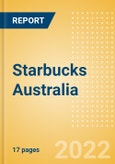Australians have a strong preference for independent cafés serving artisan and classic coffees which are often important social hubs. Starbucks failed to readjust its own model, offering, and brand image in accordance with these preferences.
From its entry into Australia in 2000 to 2008, Starbucks' outlets rose to 90, before falling to 23 that same year. Today, its Australian outlets number just 58.
From its entry into Australia in 2000 to 2008, Starbucks' outlets rose to 90, before falling to 23 that same year. Today, its Australian outlets number just 58.
Scope
- Adhering to regional and cultural preferences has a crucial impact on brand performance
- Although the coffee and tea shop channel in Australia is highly fragmented with chains facing strong competition from independents, top brands such as The Coffee Club have demonstrated it is feasible for multinational chains to have success.
- Brands entering new markets must consider why consumers visit a particular channel in that region, as well as local tastes and product formulation preferences.
Reasons to Buy
- Understand the relevant consumer trends and attitudes that drive and support innovation success so you can tap into what is really impacting the industry.
- Gain a broader appreciation of the foodservice industry by gaining insights from both within and outside of your sector.
- Access valuable strategic take-outs to help direct future decision-making and inform new product development.
Table of Contents
- What?
- Why?
- Take-Outs
- Appendix
Companies Mentioned (Partial List)
A selection of companies mentioned in this report includes, but is not limited to:
- Starbucks
- The Coffee Club








